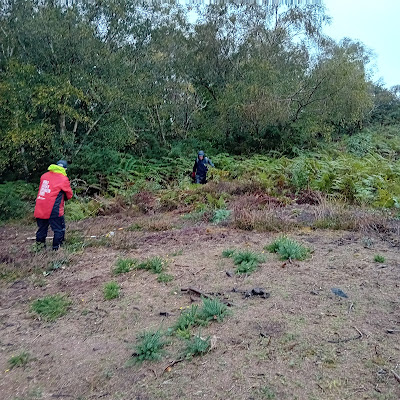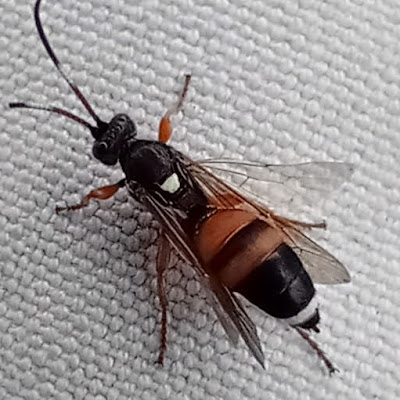In October the volunteers cleared grass, bramble and bracken which was growing in an area of sloping heath that was cut close to ground level in 2022 as part of a long term plan to increase the age range of heather across the reserve by rotational cutting of specific areas over a twenty year period. This unwanted vegetation was threatening to outgrow and shade out the small regenerating heather plants.
 |
| Clearing grass, bramble and bracken |
 |
| Managing the heathland to create space for regenerating heather plants |
During this work some interesting insects were observed in the thin surface soil and leaf litter. Several parasitoid ichneumon wasps were possibly looking for moth pupae to lay their eggs in and the very characteristically shaped bishop's mitre shield bug was running at the base of some grass tussocks. This bug has been previously recorded in several coastal dune locations across Wirral in recent years.
 |
| Ichneumon sarcitorius - female |
 |
| Bishop's mitre shield bug (Aelia acuminata) |
During November and December we worked hard on a range of tasks despite some very wet and cold weather. Overly tall birch was coppiced in the 'managed scrub' area to provide improved habitat conditions for nesting birds and, working with Graham from Cheshire Wildlife Trust, we removed and stump treated a section of unwanted tall birch and gorse from within the central heather panel. While dragging away cut birch, one of our volunteers observed an empty cocoon of an emperor moth attached to a small oak sapling, hopefully we will see some adult moths flying in the reserve in Spring.
 |
| The empty cocoon of an emperor moth found at Cleaver Heath |
Some interesting fungi were also observed at this time, thriving during the very wet conditions.
 |
| Clockwise from top left: birch polypore, common earthball on the woodland floor, turkey-tail fungus and oyster mushroom. |
 |
| Tiny bonnet mushrooms on dead bramble stem - Mycena sp. ? |
 |
| Widening a narrow section of the path |
 |
| Cutting back vegetation that had grown through the railings onto Oldfield Road |
During January and February, working with Graham from CWT, we cleared and stump treated invasive birch within the lower sloping heath and cut back and dug out many of the roots of a very large rhododendron that was growing within the woodland area.
The planned contractor-led heathland regeneration project should be going ahead shortly and we will be topping up the recently widened public paths with stone in March so plenty to do in hopefully much improved weather conditions as Spring approaches.
John McGaw
Volunteer Warden Cleaver Heath

No comments:
Post a Comment